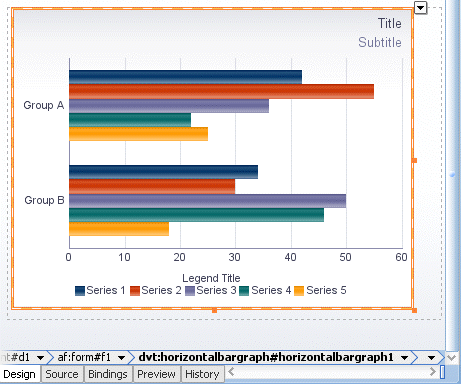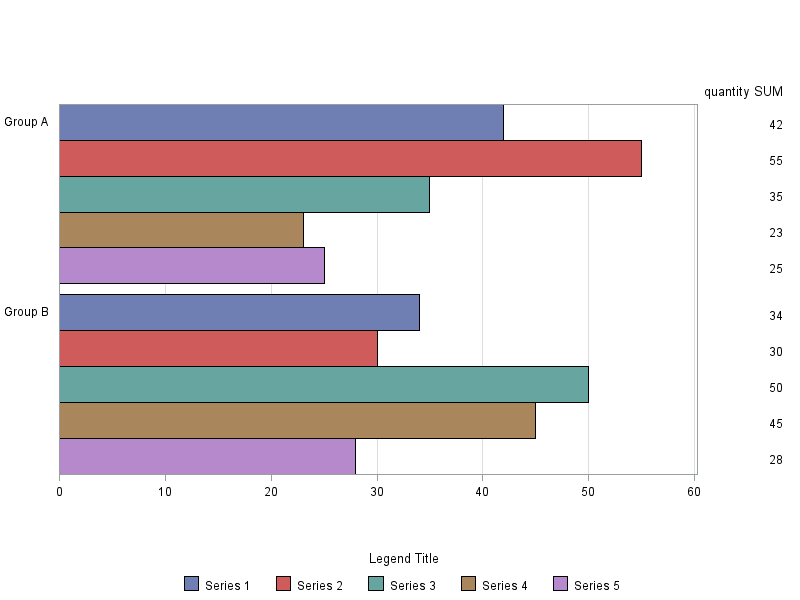- Home
- /
- Programming
- /
- Graphics
- /
- how to write a code for horizontal charts
- RSS Feed
- Mark Topic as New
- Mark Topic as Read
- Float this Topic for Current User
- Bookmark
- Subscribe
- Mute
- Printer Friendly Page
- Mark as New
- Bookmark
- Subscribe
- Mute
- RSS Feed
- Permalink
- Report Inappropriate Content
Hi
I was trying to find an example code to draw a horizontal chart like below.
I know how to write a code if there was only series 1, but I could not find any sample code online if there were multiple series 1,2,3,...5
It would be greatly appreciated if someone can let me know a sample code so I can learn from it. Thanks!

Accepted Solutions
- Mark as New
- Bookmark
- Subscribe
- Mute
- RSS Feed
- Permalink
- Report Inappropriate Content
PROC SQL;
CREATE VIEW WORK.SORTTempTableSorted AS
SELECT T.Type, T.Origin
FROM SASHELP.CARS as T
;
QUIT;
PATTERN1 COLOR = _STYLE_;
PATTERN2 COLOR = _STYLE_;
PATTERN3 COLOR = _STYLE_;
PATTERN4 COLOR = _STYLE_;
PATTERN5 COLOR = _STYLE_;
PATTERN6 COLOR = _STYLE_;
PATTERN7 COLOR = _STYLE_;
PATTERN8 COLOR = _STYLE_;
PATTERN9 COLOR = _STYLE_;
PATTERN10 COLOR = _STYLE_;
PATTERN11 COLOR = _STYLE_;
PATTERN12 COLOR = _STYLE_;
Axis1
STYLE=1
WIDTH=1
;
Axis2
STYLE=1
WIDTH=1
MINOR=NONE
;
;
TITLE;
TITLE1 "Bar Chart";
FOOTNOTE;
PROC GCHART DATA=WORK.SORTTempTableSorted
;
HBAR
Type
/
GROUP=Origin
CLIPREF
SPACE=0
FRAME TYPE=FREQ
NOLEGEND
COUTLINE=BLACK
MAXIS=AXIS1
RAXIS=AXIS2
PATTERNID=MIDPOINT
;
/* -------------------------------------------------------------------
End of task code.
------------------------------------------------------------------- */
RUN; QUIT;
- Mark as New
- Bookmark
- Subscribe
- Mute
- RSS Feed
- Permalink
- Report Inappropriate Content
What version of SAS are you running?
- Mark as New
- Bookmark
- Subscribe
- Mute
- RSS Feed
- Permalink
- Report Inappropriate Content
Try this little example and see if it works for you:
Title "Average MPG by Origin and Vehicle Type";
proc sgplot data=sashelp.cars;
hbar origin / response=mpg_city stat=mean group=type
groupdisplay=cluster datalabel;
run;
- Mark as New
- Bookmark
- Subscribe
- Mute
- RSS Feed
- Permalink
- Report Inappropriate Content
If your data is not grouped, you can overlay multiple bar charts in a manner similar to the following:
proc sgplot data=sashelp.class;
hbar age / response=weight stat=mean barwidth=0.4 discreteoffset=-0.2 datalabel;
hbar age / response=height stat=mean barwidth=0.4 discreteoffset=0.2 datalabel;
run;
- Mark as New
- Bookmark
- Subscribe
- Mute
- RSS Feed
- Permalink
- Report Inappropriate Content
You could do it with SAS/Graph Proc Gchart...
data my_data;
length my_group $20 my_series $20;
infile datalines dlm=':';
input my_group my_series quantity;
datalines;
Group A:Series 1:42
Group A:Series 2:55
Group A:Series 3:35
Group A:Series 4:23
Group A:Series 5:25
Group B:Series 1:34
Group B:Series 2:30
Group B:Series 3:50
Group B:Series 4:45
Group B:Series 5:28
;
run;
axis1 label=none value=none;
axis2 label=none;
axis3 label=none minor=none;
legend1 label=(position=top j=c 'Legend Title') shape=bar(.15in,.15in);
proc gchart data=my_data;
hbar my_series / type=sum sumvar=quantity
group=my_group subgroup=my_series space=0
maxis=axis1 gaxis=axis2 raxis=axis3
autoref clipref cref=graydd
legend=legend1;
run;

- Mark as New
- Bookmark
- Subscribe
- Mute
- RSS Feed
- Permalink
- Report Inappropriate Content
PROC SQL;
CREATE VIEW WORK.SORTTempTableSorted AS
SELECT T.Type, T.Origin
FROM SASHELP.CARS as T
;
QUIT;
PATTERN1 COLOR = _STYLE_;
PATTERN2 COLOR = _STYLE_;
PATTERN3 COLOR = _STYLE_;
PATTERN4 COLOR = _STYLE_;
PATTERN5 COLOR = _STYLE_;
PATTERN6 COLOR = _STYLE_;
PATTERN7 COLOR = _STYLE_;
PATTERN8 COLOR = _STYLE_;
PATTERN9 COLOR = _STYLE_;
PATTERN10 COLOR = _STYLE_;
PATTERN11 COLOR = _STYLE_;
PATTERN12 COLOR = _STYLE_;
Axis1
STYLE=1
WIDTH=1
;
Axis2
STYLE=1
WIDTH=1
MINOR=NONE
;
;
TITLE;
TITLE1 "Bar Chart";
FOOTNOTE;
PROC GCHART DATA=WORK.SORTTempTableSorted
;
HBAR
Type
/
GROUP=Origin
CLIPREF
SPACE=0
FRAME TYPE=FREQ
NOLEGEND
COUTLINE=BLACK
MAXIS=AXIS1
RAXIS=AXIS2
PATTERNID=MIDPOINT
;
/* -------------------------------------------------------------------
End of task code.
------------------------------------------------------------------- */
RUN; QUIT;
- Mark as New
- Bookmark
- Subscribe
- Mute
- RSS Feed
- Permalink
- Report Inappropriate Content
Thank you so much for all of your quick responses!! All of them are very useful. Thanks again!
Hi Hai.kuo, I was trying to understand the meaning of each lines of your code, but may I know why you have 12 lines of PATTERN statement?
I read about it in the link below, but I still wasn't sure why there had to be 12 lines of these because there are only 6 types of cars?
Thanks very much!
- Mark as New
- Bookmark
- Subscribe
- Mute
- RSS Feed
- Permalink
- Report Inappropriate Content
You have Robert and Dan who are way better expert than I am regarding SAS/Graph, and way better qualified to answer your question ![]() .
.
Like I said, I cheated, the code was machine generated from a Task in Eguide, and to be honest, this is one of the major reasons I like EG.
Haikuo
April 27 – 30 | Gaylord Texan | Grapevine, Texas
Registration is open
Walk in ready to learn. Walk out ready to deliver. This is the data and AI conference you can't afford to miss.
Register now and lock in 2025 pricing—just $495!
Learn how use the CAT functions in SAS to join values from multiple variables into a single value.
Find more tutorials on the SAS Users YouTube channel.
SAS Training: Just a Click Away
Ready to level-up your skills? Choose your own adventure.



